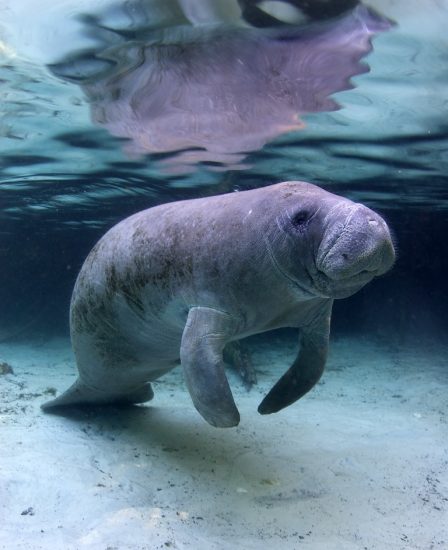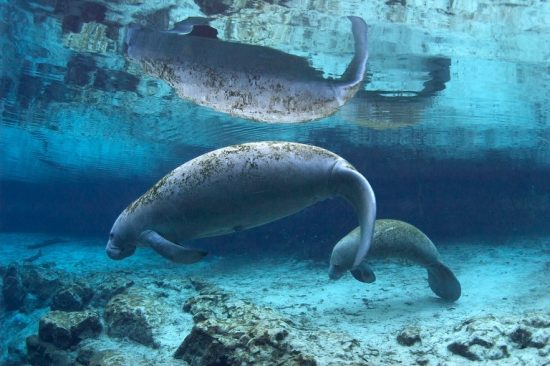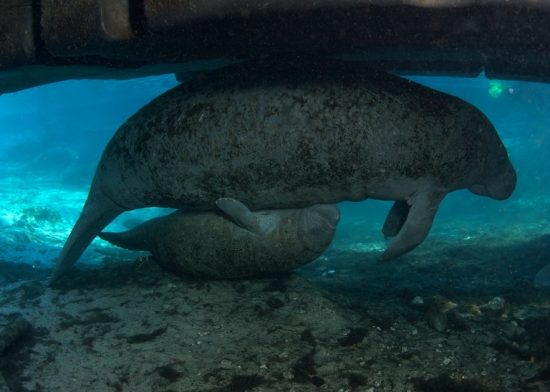






Manatee population to slowly grow and shift northward
Florida's manatee population is likely
to endure for the next century, provided wildlife managers continue to
protect them and their habitat, according to a new study by the US
Geological Survey (USGS) and the Florida Fish and Wildlife Research
Institute (FWRI).
In the study, veteran manatee scientists estimated there is less than a
one-half of one percent chance that either Florida's Atlantic or its
Gulf of Mexico manatee population could fall to as few as 500 adults -
a level that could threaten the manatees' survival in the long term.
Lead author and USGS research ecologist Michael C. Runge said, “Today,
the Florida manatees' numbers are high. Adult manatees' longevity is
good, and the state has available habitat to support a population that
is continuing to grow.”
"Still, new threats could emerge, or
existing threats could interact in unexpected ways. Managers need to
remain vigilant to keep manatee populations viable over the long haul,” he cautioned.
From about 1,000 individuals in the mid-1970s, Florida's manatee
population has grown to 6,620 in early 2017 due to boat speed
regulations, habitat protection and other measures.
Based on the team's assessment, the population will probably slowly
double over the next 50 years and then level off. Over time, the
population as a whole will remain high. Specifically, environmental and
habitat changes are likely to cause the population in South Florida to
become less abundant and the population in North Florida to be more
numerous.
Scientists of the Sirenia Project have studied manatees since the
1970s, photographing more than 3,000 animals and identifying them from
each individual's unique pattern of propeller scars and other markings.
From a database that contains more than 750,000 manatee photographs,
satellite tracking, genetic information and other data, the USGS and
FWRI have achieved a strong understanding of how manatees interact with
their environment.
At USGS' Patuxent Wildlife Research Center in Laurel, Maryland, all
this information is entered into a computer model that assesses how
Florida manatee populations are faring at present and in the coming
decades. The model is updated periodically, incorporating insights from
experts and new information about changing conditions.
Based on the latest overview, the manatee populations will continue to
face two major threats in the coming decades: fatal boat collisions,
and the loss of warm-water habitats that provide them with refuge
during the winter. Red tides are another possible threat, if they
become more frequent and intense in the coming decades.
The researchers tested many scenarios in a bid to find out a set of
circumstances that would trigger a statewide decline in the manatee
population.
The next century is likely to see the population shift around the state
in response to regional environmental changes. For instance, some
southeast Florida power plants are expected to shut down over the next
40 to 50 years. If this happened, manatees will lose the warm water
refuges created in the plants' discharge canals. Manatees in southwest
Florida are likely to be increasingly affected by red tide and may also
lose some warm water refuges. As a result, the manatee populations in
southeast and southwest Florida may decline.
However, this would be balanced by increased manatee numbers in
northeast and northwest Florida, where warm natural springs are capable
of hosting more manatees.
“Manatee populations will continue to
face threats. But if these threats continue to be managed effectively,
manatees will be an integral and iconic part of Florida's coastal
ecosystems through the coming century,” said Runge.
Video (youTube): https://www.youtube.com/watch?v=4Pgd1O00psA
 Herbert
Herbert 20th April 2017
20th April 2017 Crystal River, Florida, USA
Crystal River, Florida, USA